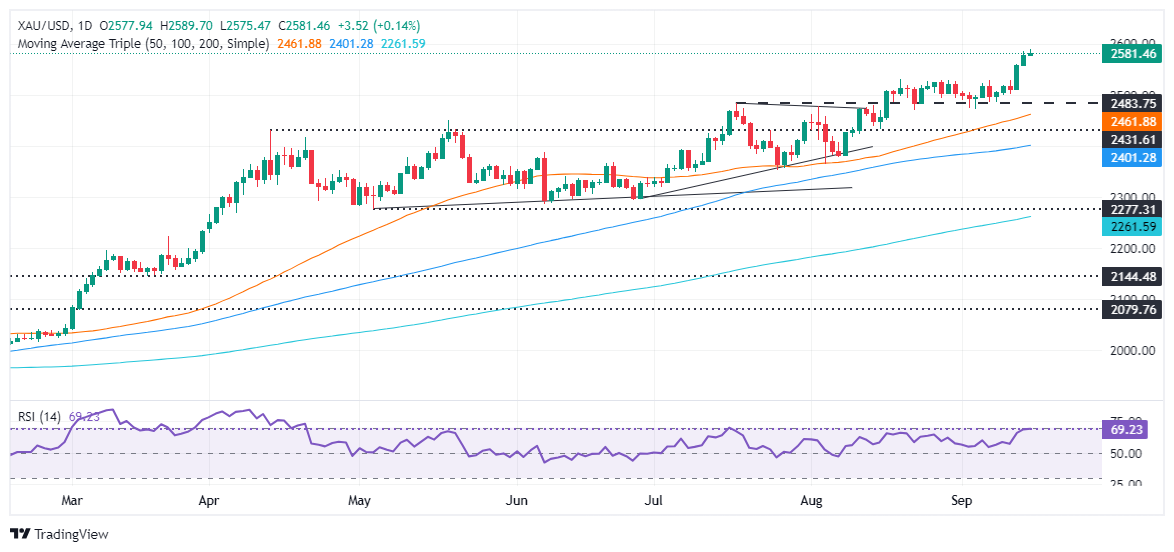Gold soars as US yields drop ahead of US Retail Sales and Fed’s decision
Fxstreet
Sep 16, 2024 7:30 PM
- Gold prices rise as odds for a 50 bps Fed rate cut increase to 59%, supported by falling US Treasury yields.
- US Dollar Index (DXY) drops 0.36% to 100.74, boosting the non-yielding metal.
- Traders await US Retail Sales on Tuesday and housing data ahead of Fed decision and Jerome Powell’s press conference on Wednesday.
Gold price posted gains of over 0.18% during the North American session on Monday, bolstered by a weaker US Dollar as traders eye Wednesday’s US Federal Reserve (Fed) monetary policy decision. Expectations for a larger-than-expected rate cut bolstered the XAU/USD, which trades at $2,582 after bouncing off a daily low of $2,579.
Market sentiment is mixed ahead of the Fed’s decision. Data shows that the chances that Jerome Powell and his colleagues will deliver a 50-basis-point (bps) cut are growing. The CME FedWatch Tool shows that odds for a 50 bps cut rose from 50% to 59%, while for a 25 bps cut they stand at 41%.
The drop in US Treasury yields also supported the golden metal. The US 10-year benchmark T-note is falling two and a half bps to 3.631%, a tailwind for the non-yielding metal.
Consequently, this weighed on the Greenback, which according to the US Dollar Index (DXY) fell 0.36% to 100.74.
In the geopolitical space, risks of an escalation of the Middle East conflict remain while an apparent assassination attempt against former US President Donald Trump weakened the Greenback, according to Bloomberg.
Looking ahead, the US economic schedule will feature August Retail Sales on Tuesday. These are foreseen dropping compared to July’s solid results and are expected to guide the size of the Fed’s cut. Additionally, housing data will be released ahead of the Fed's decision and Chair Jerome Powell's press conference later in the week.
Daily digest market movers: Gold price remains steady above $2,580
- Wall Street economists estimate that US Retail Sales will decline from 1% to 0.2% MoM.
- US Industrial Production is expected to improve from July's -0.6% contraction to 0%.
- Besides the Federal Open Market Committee Decision (FOMC), investors will eye the Summary of Economic Projections (SEP), particularly the Dot Plot for forward guidance on interest rates.
- Data from the Chicago Board of Trade suggests that the Fed is expected to cut at least 112 basis points this year, based on the fed funds rate futures contract for December 2024.
XAU/USD technical outlook: Gold price headed for $2,600
Gold's uptrend remains intact, supported by solid demand and momentum. The Relative Strength Index (RSI) is in bullish territory, staying just below the 80 level, which traders often see as an "extreme" overbought in strong trending conditions.
If XAU/USD clears the all-time high (ATH) of $2,589, the next stop would be $2,600. If surpassed, further upside could be expected with the psychological levels of $2,650 and $2,700 up next.
On the downside, Gold sellers must push prices below $2,550 to regain control. Key support levels after that include the August 20 high at $2,531, followed by the critical $2,500 mark.

Economic Indicator
Fed Interest Rate Decision
The Federal Reserve (Fed) deliberates on monetary policy and makes a decision on interest rates at eight pre-scheduled meetings per year. It has two mandates: to keep inflation at 2%, and to maintain full employment. Its main tool for achieving this is by setting interest rates – both at which it lends to banks and banks lend to each other. If it decides to hike rates, the US Dollar (USD) tends to strengthen as it attracts more foreign capital inflows. If it cuts rates, it tends to weaken the USD as capital drains out to countries offering higher returns. If rates are left unchanged, attention turns to the tone of the Federal Open Market Committee (FOMC) statement, and whether it is hawkish (expectant of higher future interest rates), or dovish (expectant of lower future rates).
Read more.Next release: Wed Sep 18, 2024 18:00
Frequency: Irregular
Consensus: 5.25%
Previous: 5.5%
Source: Federal Reserve
